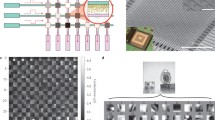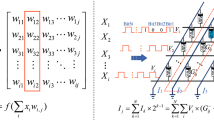Abstract
Memristor is a nanoscale circuit element with nonvolatile, binary, multilevel and analog states. Its conductance (resistance) plasticity is similar to biological synapses. Information sparse coding is considered as the key mechanism of biological neural systems to process mass complex perception data, which is applied in the fields of signal processing, computer vision and so on. This paper proposes a soft-threshold adaptive sparse coding algorithm named MMN-SLCA based on the memristor, neural network and sparse coding theory. Specifically, the memristor crossbar array is used to realize the dictionary set. And by leveraging its unique vector–matrix operation advantages and biological synaptic characteristic, two key compositions of the sparse coding, namely, pattern matching and lateral neuronal inhibition are realized conveniently and efficiently. Besides, threshold variability further enhances the adaptive ability of the intelligent sparse coding. Furthermore, a hardware implementation framework of the sparse coding algorithm is designed to provide feasible solutions for hardware acceleration, real-time processing and embedded applications. Finally, the application of MMN-SLCA in image super-resolution reconstruction is discussed. Experimental simulations and result analysis verify the effectiveness of the proposed scheme and show its superior potentials in large-scale low-power intelligent information coding and processing.














Similar content being viewed by others
References
Adhikari SP, Yang C, Kim H (2012) Memristor bridge synapse-based neural network and its learning. IEEE Trans Neural Netw Learn Syst 23(9):1426–1435
Bao B, Jiang T, Wang G (2017) Two-memristor-based Chua’s hyperchaotic circuit with plane equilibrium and its extreme multistability. Nonlinear Dyn 89(2):1157–1171
Bao H, Wang N, Bao B (2018) Initial condition-dependent dynamics and transient period in memristor-based hypogenetic jerk system with four line equilibria. Commun Nonlinear Sci Numer Simul 57:264–275
Bao H, Liu W, Hu A (2019) Coexisting multiple firing patterns in two adjacent neurons coupled by memristive electromagnetic induction. Nonlinear Dyn 95(1):43–56
Candès EJ, Wakin MB (2008) An introduction to compressive sampling. IEEE Signal Process Mag 25(2):21–30
Chen L, Li C, Huang T (2013) A synapse memristor model with forgetting effect. Phys Lett A 377(45–48):3260–3265
Chua L (1971) Memristor-the missing circuit element. IEEE Trans Circuit Theory 18(5):507–519
Donoho DL, Elad M (2003) Optimally sparse representation in general (nonorthogonal) dictionaries via ℓ1 minimization. Proc Natl Acad Sci 100(5):2197–2202
Field DJ (1987) Relations between the statistics of natural images and the response properties of cortical cells. J Opt Soc 4(12):2379–2394
Field DJ (1989) What the statistics of natural images tell us about visual coding. Hum Vis Vis Process Digit Disp 1077:269–277
Hu X, Feng G, Duan S (2017) A memristive multilayer cellular neural network with applications to image processing. IEEE Trans Neural Netw Learn Syst 28(8):1889–1901
Itoh M, Chua L (2014) Memristor cellular automata and memristor discrete-time cellular neural networks. In: Memristor networks. Springer, Cham, pp 649–713
Jo SH, Chang T (2010) Nanoscale memristor device as synapse in neuromorphic systems. Nano Lett 10(4):1297–1301
Kawahara A, Azuma R, Ikeda Y (2013) An 8 Mb multi-layered cross-point ReRAM macro with 443 MB/s write throughput. IEEE J Solid-State Circuits 48(1):178–185
Kvatinsky S, Friedman EG, Kolodny A (2013) TEAM: threshold adaptive memristor model. IEEE Trans Circuits Syst I Regul Pap 60(1):211–221
Lazzaro J, Ryckebusch S, Mahowald M A (1989) Winner-take-all networks of O(n) complexity. In: Advances in neural information processing systems, pp 703–711
Li Y, Cichocki A, Amari S (2004) Analysis of sparse representation and blind source separation. Neural Comput 16(6):1193–1234
Long S, Perniola L, Cagli C (2013) Voltage and power-controlled regimes in the progressive unipolar RESET transition of HfO 2-based RRAM. Sci Rep 3:2929
Muenstermann R, Menke T, Dittmann R (2010) Coexistence of filamentary and homogeneous resistive switching in Fe-doped SrTiO3 thin-film memristive devices. Adv Mater 22(43):4819–4822
Olshausen BA, Field DJ (1997) Sparse coding with an overcomplete basis set: A strategy employed by V1? Vis Res 37(23):3311–3325
Pershin YV, Di Ventra M (2010) Practical approach to programmable analog circuits with memristors. IEEE Trans Circuits Syst I Regul Pap 57(8):1857–1864
Rozell CJ, Johnson DH, Baraniuk RG (2008) Sparse coding via thresholding and local competition in neural circuits. Neural Comput 20(10):2526–2563
Sheridan PM, Cai F, Du C (2017) Sparse coding with memristor networks. Nat Nanotechnol 12(8):784
Snider G, Amerson R, Carter D (2011) From synapses to circuitry: using memristive memory to explore the electronic brain. Computer 44(2):21–28
Strukov DB, Snider GS, Stewart DR (2008) The missing memristor found. Nature 453(7191):80–83
Wang X, Chen Y, Xi H (2009) Spintronic memristor through spin-torque-induced magnetization motion. IEEE Electron Device Lett 30(3):294–297
Wang M, Cai S, Pan C (2018) Robust memristors based on layered two-dimensional materials. Nat Electron 1(2):130
Wright J, Ma Y, Mairal J (2010) Sparse representation for computer vision and pattern recognition. Proc IEEE 98(6):1031–1044
Yan B, Chen Y, Li H (2018) Challenges of memristor based neuromorphic computing system. Sci China Inf Sci 61(6):060425
Yang JJ, Strukov DB, Stewart DR (2013) Memristive devices for computing. Nat Nanotechnol 8(1):13
Yang Y, Chang T, Lu W (2014) Memristive devices: switching effects, modeling, and applications. In: Memristors and memristive systems. Springer, New York, NY, pp 195–221
Yesil A (2018) A new grounded memristor emulator based on MOSFET-C. AEU-Int J Electron Commun 91:143–149
Zakhidov AA, Jung B, Slinker JD (2010) A light-emitting memristor. Org Electron 11(1):150–153
Zhang F, Duan S, Wang L (2017) Route searching based on neural networks and heuristic reinforcement learning. Cogn Neurodyn 11(3):245–258
Acknowledgements
This work was supported by National Natural Science Foundation of China (Grant No. 61601376, 61672436), Fundamental Research Funds for the Central Universities (XDJK2019C034), Fundamental Science and Advanced Technology Research Foundation of Chongqing (cstc2016jcyjA0547), China Postdoctoral Science Foundation Special Funded (2018T110937), Chongqing Postdoctoral Science Foundation Special Funded (Xm2017039), Student’s Platform for Innovation and Entrepreneurship Training Program (201810635017).
Author information
Authors and Affiliations
Corresponding author
Additional information
Publisher's Note
Springer Nature remains neutral with regard to jurisdictional claims in published maps and institutional affiliations.
Rights and permissions
About this article
Cite this article
Ji, X., Hu, X., Zhou, Y. et al. Adaptive sparse coding based on memristive neural network with applications. Cogn Neurodyn 13, 475–488 (2019). https://doi.org/10.1007/s11571-019-09537-w
Received:
Revised:
Accepted:
Published:
Issue Date:
DOI: https://doi.org/10.1007/s11571-019-09537-w




